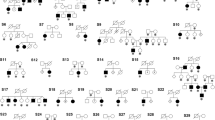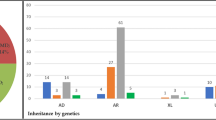Abstract
Stargardt-like macular dystrophy (STGD3, MIM 600110) and autosomal dominant macular dystrophy (adMD) are inherited forms of macular degeneration characterized by decreased visual acuity, macular atrophy and extensive fundus flecks1,2,3. Genetic mapping data suggest that mutations in a single gene may be responsible for both conditions, already known to bear clinical resemblance1,2,3. Here we limit the minimum genetic region for STGD3 and adMD to a 0.6-cM interval by recombination breakpoint mapping and identify a single 5-bp deletion within the protein-coding region of a new retinal photoreceptor-specific gene, ELOVL4, in all affected members of STGD3 and adMD families. Bioinformatic analysis of ELOVL4 revealed that it has homology to a group of yeast proteins that function in the biosynthesis of very long chain fatty acids. Our results are therefore the first to implicate the biosynthesis of fatty acids in the pathogenesis of inherited macular degeneration.
This is a preview of subscription content, access via your institution
Access options
Subscribe to this journal
Receive 12 print issues and online access
$209.00 per year
only $17.42 per issue
Buy this article
- Purchase on Springer Link
- Instant access to full article PDF
Prices may be subject to local taxes which are calculated during checkout






Similar content being viewed by others
References
Stone, E.M. et al. Clinical features of a Stargardt-like dominant progressive macular dystrophy with genetic linkage to chromosome 6q. Arch. Ophthalmol. 112, 765–772 (1994).
Edwards, A.O. et al. Autosomal dominant Stargardt-like macular dystrophy: I. clinical characterization, longitudinal follow-up, and evidence for a common ancestry in families linked to chromosome 6q14. Am. J. Ophthalmol. 127, 426–435 (1999).
Griesinger, I.B., Sieving, P.A. & Ayyagari, R. Autosomal dominant macular atrophy at 6q14 excludes CORD7 and MCDR1/PBCRA loci. Invest. Ophthalmol. Vis. Sci. 41, 248–255 (2000).
Lagali, P.S. et al. Autosomal dominant Stargardt-like macular dystrophy segregating in a large Canadian family. Can. J. Ophthalmol. 5, 315–324 (2000).
Oh, C.S., Toke, D.A., Mandala, S. & Martin, C.E. ELO2 and ELO3, homologues of the Saccharomyces cerevisiae ELO1 gene, function in fatty acid elongation and are required for sphingolipid formation. J. Biol. Chem. 272, 17376–17384 (1997).
Tvrdik, P. et al. Cig30, a mouse member of a novel membrane protein gene family, is involved in the recruitment of brown adipose tissue. J. Biol. Chem. 272, 31738–31746 (1997).
Tvrdik, P. et al. Role of a new mammalian gene family in the biosynthesis of very long chain fatty acids and sphingolipids. J. Cell Biol. 149, 707–318 (2000).
Shanklin, J., Whittle, E. & Fox, B.G. Eight histidine residues are catalytically essential in a membrane-associated iron enzyme, stearoyl-CoA desaturase, and are conserved in alkane hydroxylase and xylene monooxygenase. Biochemistry 33, 12787–12794 (1994).
Jackson, M.R., Nilsson, T. & Peterson, P.A. Identification of a consensus motif for retention of transmembrane proteins in the endoplasmic reticulum. EMBO J. 9, 3153–162 (1990).
Jackson, M.R., Nilsson, T. & Peterson, P.A. Retrieval of transmembrane proteins to the endoplasmic reticulum. J. Cell Biol. 121, 317–333 (1993).
Schroder, S., Schimmoller, F., Singer-Kruger, B. & Riezman, H. The Golgi-localization of yeast Emp47p depends on its di-lysine motif but is not affected by the ret1-1 mutation in α-COP. J. Cell Biol. 131, 895–912 (1995).
Cinti, D.L., Cook, L., Nagi, M.N. & Suneja, S.K. The fatty acid chain elongation system of mammalian endoplasmic reticulum. Prog. Lipid Res. 31, 1–51 (1992).
Allikmets, R.L. et al. A photoreceptor cell-specific ATP-binding transporter gene (ABCR) is mutated in recessive Stargardt macular dystrophy. Nature Genet. 15, 236–246 (1997).
Sun, H. & Nathans, J. Stargardt's ABCR is localized to the disc membrane of retinal rod outer segments. Nature Genet. 17, 15–16 (1997).
Illing, M., Molday, L.L. & Molday, R.S. The 220-kDa rim protein of retinal rod outer segments is a member of the ABC transporter superfamily. J. Biol. Chem. 11, 10303–10310 (1997).
Molday, L.L., Rabin, A.R. & Molday, R.S. ABCR expression in foveal cone photoreceptors and its role in Stargardt macular dystrophy. Nature Genet. 25, 257–258 (2000).
Allikmets, R. et al. Evaluation of the Best disease gene in patients with age-related macular degeneration and other maculopathies. Hum. Genet. 104, 449–453 (1999).
Fliesler, S.J. & Anderson, R.E. Chemistry and metabolism of lipids in the vertebrate retina. Prog. Lipid Res. 22, 79–131 (1983).
Sprecher, H., Luthria, D.L. Mohammed, B.S. & Baykousheva, S.P. Reevaluation of the pathways for the biosynthesis of polyunsaturated fatty acids. J. Lipid Res. 36, 2471–2477 (1995).
Luthria, D.L., Mohammed, B.S. & Sprecher, H. Regulation of the biosynthesis of 4,7,10,13,16,19-docosahexaenoic acid. J. Biol. Chem. 271, 16020–16025 (1996).
Weng, J. et al. Insights into the function of Rim protein in photoreceptors and etiology of Stargardt's disease from the phenotype in abcr knockout mice. Cell 98, 13–23 (1999).
Sun, H., Molday, R.S. & Nathans, J. Retinal stimulates ATP hydrolysis by purified and reconstituted ABCR, the photoreceptor-specific ATP-binding cassette transporter responsible for Stargardt disease. J. Biol. Chem. 274, 8269–8281 (1999).
Ahn, J., Wong, J.T. & Molday, R.S. The effect of lipid environment and retinoids on the ATPase activity of ABCR, the photoreceptor ABC transporter responsible for Stargardt macular dystrophy. J. Biol. Chem. 275, 20399–20405 (2000).
Petrukhin, K. et al. Identification of the gene responsible for Best macular dystrophy. Nature Genet. 19, 241–247 (1998).
Stone, E.M. et al. A single EFEMP1 mutation associated with both Malattia Leventinese and Doyne honeycomb retinal dystrophy. Nature Genet. 22, 199–202 (1999).
Weber, B.H., Vogt, G., Pruett, R.C., Stohr, H. & Felbor, U. Mutations in the tissue inhibitor of metalloproteinases-3 (TIMP3) in patients with Sorsby's fundus dystrophy. Nature Genet. 8, 352–356 (1994).
Zhang, K., Bither, P.P., Park, R., Donoso, L.A., Seidman, J.G. & Seidman, C.E. A dominant Stargardt's macular dystrophy locus maps to chromosome 13q34. Arch. Ophthalmol. 112, 759–764 (1994).
Shah, A.B. et al. Identification and analysis of mutations in the Wilson disease gene (ATP7B): population frequencies, genotype-phenotype correlation, and functional analyses. Am. J. Hum. Genet. 61, 317–328 (1997).
Austin, C.P., Feldman, D., Ida, J. & Cepko, C.L. Vertebrate retinal ganglion cells are selected from competent progenitors by the action of Notch. Development 121, 3637–3650 (1995).
Kyte, J. & Doolittle, R.F. A simple method for displaying the hydropathic character of a protein. J. Mol. Biol. 157, 105–132 (1982).
Acknowledgements
We thank the members of the sequencing group (Merck Research Labs) for shotgun cloning and sequencing; C.T. Caskey for support and advice; A. Marmorstein and J. Hollyfield for helpful discussions; M. Rayborn for critical reading of the manuscript; J. Seidman, C. Seidman and P. Bither for advice and help in the early phase of this work; Y. Shugart for help with linkage analysis; and patients with STGD3 and adMD and members of their families for participation. Supported by NIH EY00401 and Grant Ritter Fund (K.Z.), Helen Keller Eye Research Foundation (Y.L.), Foundation Fighting Blindness, Hunt Valley, Maryland (D.J.Z., P.A.S., R.A.), E.A. Baker Foundation, AHFMR, and Foundation Fighting Blindness, Canada (P.W.W.), and Howard Hughes Medical Institute, of which M.H. is an assistant investigator. This research was supported in part by funding provided to Johns Hopkins University under a Research Collaboration Agreement between Johns Hopkins University and Merck & Co., Inc.
Author information
Authors and Affiliations
Corresponding author
Rights and permissions
About this article
Cite this article
Zhang, K., Kniazeva, M., Han, M. et al. A 5-bp deletion in ELOVL4 is associated with two related forms of autosomal dominant macular dystrophy. Nat Genet 27, 89–93 (2001). https://doi.org/10.1038/83817
Received:
Accepted:
Issue Date:
DOI: https://doi.org/10.1038/83817
This article is cited by
-
Effects of the administration of Elovl5-dependent fatty acids on a spino-cerebellar ataxia 38 mouse model
Behavioral and Brain Functions (2022)
-
Whole exome sequencing analysis identifies novel Stargardt disease-related gene mutations in Chinese Stargardt disease and retinitis pigmentosa patients
Eye (2022)
-
Intrinsic differences in rod and cone membrane composition: implications for cone degeneration
Graefe's Archive for Clinical and Experimental Ophthalmology (2022)
-
Neuropathology of SCA34 showing widespread oligodendroglial pathology with vacuolar white matter degeneration: a case study
Acta Neuropathologica Communications (2021)
-
Photoreceptor metabolic reprogramming: current understanding and therapeutic implications
Communications Biology (2021)



